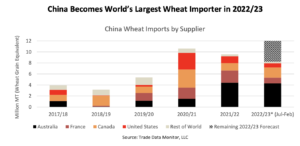Congress has quickly engaged in putting together potential aid packages for farmers that would more than double the Trump administration's $12 billion under the Farmer Bridge Assistance (FBA) Program.
For Second Week in a Row, Corn and Soybean Conditions Fall
DTN Managing Editor Anthony Greder reported yesterday that, “U.S. corn and soybean conditions fell for a second week in a row during the week ended Sunday, June 18, according to USDA NASS’ weekly Crop Progress report released Tuesday. The report, which is normally released on Mondays, was delayed this week due to the Juneteenth holiday.
“Already stressed crops could see more pressure for at least part of this week, as a couple of ridges of high pressure in the upper atmosphere are combining to bring widespread heat and dryness from Texas through the Great Lakes, according to DTN forecasts.”
With respect to corn, Greder indicated that, “Crop condition: Nationally, corn was rated 55% good to excellent, down 6 percentage points from 61% the previous week and below last year’s rating at this time of 70%.”
“‘The poor-to-very-poor portion of the crop rose 4 points to 12%,’ noted DTN Senior Analyst Dana Mantini. ‘Corn in Illinois was rated 36% good to excellent, down 12 points from last week. Michigan was also poor, at 32% good to excellent, while Iowa corn condition was rated 59% good to excellent.'”

Turning to soybeans, the DTN article stated that, “Crop condition: Soybeans were rated 54% good to excellent as of Sunday. That’s 5 percentage points lower than last week’s 59%, 14 points below 68% last year at this time, and the lowest good-to-excellent rating for the crop for this date since 1996. ‘As with corn, many of the larger drops in ratings came from Eastern states,’ Mantini said. ‘Illinois’ crop was just 33% good to excellent, while Michigan was just 23% good to excellent with 32% of that crop poor to very poor. Iowa is at 56% good to excellent, and Nebraska’s soybeans were rated 50% good to excellent.'”

Dow Jones writer Kirk Maltais reported yesterday that, “The chief factor moving grain futures is uncertainty over what effect the forecast will have on nascent U.S. grain crops, with rainfall lacking in the past week and dryness expected to linger in the coming weeks.”
The last 30 days across the Midwest had more water lost (evaporation) than gained (rainfall). These data from @CoCoRaHS show ~2-6 inches of water deficit in the Midwest. Explore more at https://t.co/Pjkjk50rDS#agchat #drought @DroughtGov pic.twitter.com/ASLxhuxzie
— MRCC (@MidwestClimate) June 20, 2023
Reuters writer Matthew Chye reported today that, “Chicago corn futures rose on Wednesday as dry conditions in key areas of the U.S. Midwest raised supply concerns and prompted heavy buying.”
“The U.S. Department of Agriculture cut its corn and soy crop ratings more than expected on Tuesday, including steep drops in top-producing states Iowa and Illinois, as a deepening drought stressed crops in the heart of the Midwest farm belt,” the Reuters article said.
The article added that, “United Nations Secretary-General Antonio Guterres called for an acceleration of Black Sea grain shipments from Ukrainian ports under a deal allowing safe wartime exports, a U.N. spokesperson said on Tuesday as Russia threatens to quit the pact next month.”
Elsewhere, Bloomberg News reported yesterday that, “Add wheat to the extensive list of commodities markets dominated by Chinese buyers.

“Already the world’s top importer of corn and soybeans, the nation is now poised to overtake Egypt and Turkey as the biggest buyer of wheat in the year through June, Chinese and US official data show.

“Purchases exceeded 12 million tons in the first 11 months of the marketing year, which runs through June. More than half of those cargoes were supplied by Australia.”





